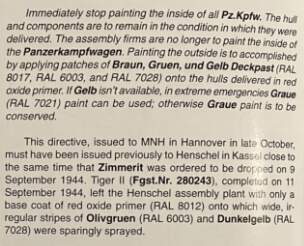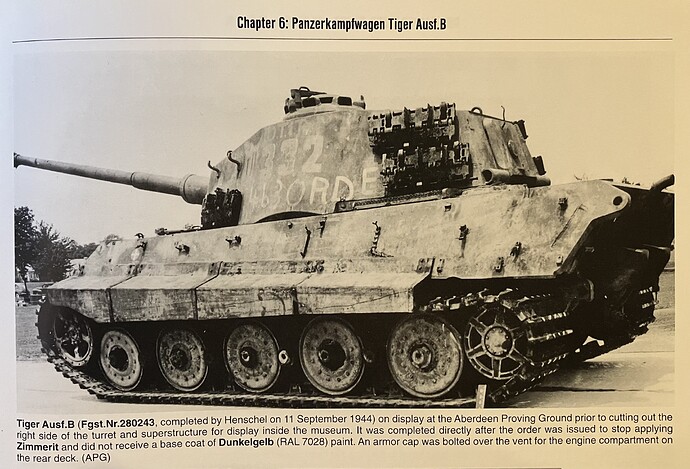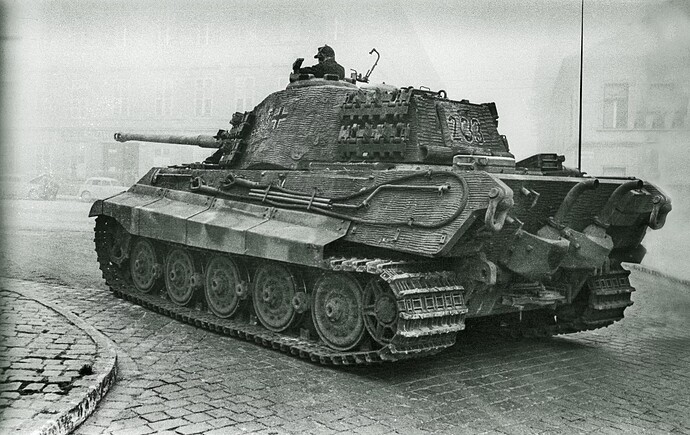G’day all
I know the order for factory applied Zimm coating ceased around Sep44 & that all the pre-production (i.e. commonly ‘Porsche’ turreted) vehicles had the coating. What about the production (I.e. commonly ‘Henschel’ turreted) vehicles? At what point in the number sequence did these vehicles stop receiving the coating? Is it easier to classify by which Btn received tanks with/without?
? bump
Not much help as you probably already know from your post above …
“Zimmerit was discontinued from factory application on 9 September 1944 and from field application on 7 October 1944”
It may be hard tracking down an exact Veh number as to when it stopped, maybe the only way will be to cross ref available images to units with dates where Zim is visible or not ?
I would imagine that units would receive and have wagons both with and without Zim as old wagons either survived or got knocked out and replacements came in after Oct with clean hulls ??
Some Tiger II images …
Probably as close as we’re going to get.
Originally assigned to sPzAbt 509, later transferred to the 501st, captured in the BoB.
Thanks mate. Are we to assume then, based on the caption attached to the pic, that this vehicle left the factory in a base colour of either: Dark Green or primer?
Since this particular vehicle was pretty much the first one to be released to service immediately after the order for zimm ceased (i.e. Sept '44), I was of the understanding that all camo was factory applied at that stage, therefore wouldn’t this tank had been finished in Dark Yellow?
To quote Thomas Jentz;

Even though the order is dated Oct.31st, 1944, the Henschel assembly plant apparently adopted it by Sept. 11th, hence it was painted as Jenzt describes it above. This single statement made by Jentz has caused more confusion and misinterpretation than any other in modeling history. The intent of the order was to reduce the amount of paint used to cover the vehicle, since painting camouflage colors on top of the overall base-coat of Dunkelgelb was essentially wasting Dunkelgelb paint. This statement has been misinterpreted as meaning Red Oxide primer was to remain visible as an additional camo color. While we can see examples of Red Oxide primer showing through near the edges where the other colors would overlap, due to the use of overly-thinned paint or poor application technique, the intent was not to leave Red Oxide primer as a finished color. An example of of Red Oxide remaining visible, for whatever reason, can be seen on the video of the late war Stug III at Ft. Benning, still in its original paint.
Another example of Red Oxide remaining visible can be found on Tiger IIs and Jagdtigers that have lost their side mudguards, exposing the underlying Red Oxide primer.
Here is a propaganda photo of two German and Hungarian soldiers smoking alongside a Tiger II. Of interest is the Zimmerit coating on the Henschel Panzer VI(B).
Bill

All Tiger IIs (with production turrets) from Fgst.Nr. 280048, completed in June 1944, through on or about Sept 11, immediately proceeding Fgst. Nr. 280243 were finished with Zimmerit.
Tiger 233, sPzAbt 503, near St. George’s square, Budapest, Oct. 15 or 16th, 1944.
Thank you. ![]()

